Note: Many things have changed since we took this trip, so some statements are out of date. For example, motel-style accommodation is now available at many of the campgrounds and roadhouses. These motel units are frequently of a very basic “donga” style, and share the toilet and shower block for the campground, but they are a great improvement for people who don’t want to camp. We’ve updated many of the links to other information sources, but we haven’t (yet) attempted to add notes on all the other changes.
This page was originally written at Innaminka, South Australia, one of the most remote towns in Australia.
Our immediate goal is Lake Eyre in South Australia. So far we’ve amended our tentative route several times, following suggestions from people we met along the way. It’s a great way to see the country, because you hear about places you hadn’t heard about before, and you learn which roads are in good or bad condition – particularly important when heavier-than-usual rains earlier in the year had caused damage to some of the roads.
So far our trek has taken us to Mackay, Nebo, Clermont, Capella, Emerald, Anakie, Alpha, Jericho, Barcaldine, Blackall, Augathella, Charleville, Cunnamulla, Eulo, Thargomindah, and the Noccundra Pub in Queensland, then to Innaminka in South Australia. When we get a chance, we’ll put together a map of our route, like we did for last year’s trip. If you’re interested in the writeup of that trip, it starts here.
The next sections of this issue cover in more detail some of the places mentioned above. See Part 2, Part 3 and Part 4. A map of the whole trip is here. The map below shows the route covered in this newsletter, from Airlie Beach to Charleville.
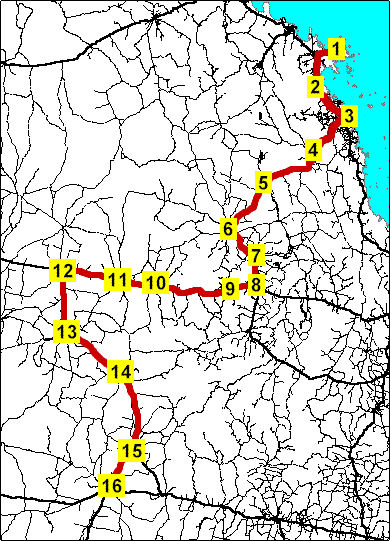
|
Legend:
|
Airlie Beach to Mackay
Friday 13 July 2001.
Since nearly everything was already in the truck, we had only to empty fridges at home, pack ice boxes, gather up our computers and last minute extras,
and take them to the motorhome. That alone took us until 10:30. Redistributing everything seemed to take ages, as always. Packing a motorhome, no matter what size, seems like solving one of those puzzles where only one vacant space is available, and that is always someplace you don’t want it.
Eric drove the motorhome into Airlie Beach and filled the rear water tank from the council tap (faucet). A council truck was nearby, so he chatted with the occupants about local matters, just to prove he was a resident. A police car drove by, with the occupants looking at him suspiciously. He waved to them, and as usual in that situation, they drove away. We finally got away from Airlie Beach at about midday.
Our first stop was Bloomsbury, 60 km or so south down the Bruce Highway from Proserpine, for one of the most unpleasant tasks of the first day, refuelling. About 20 minutes later, we had 413 litres of diesel pumped into the two tanks, and a credit card bill for A$359.18, but it is by far the cheapest fuel in a 100 km range (10c per litre less than in Airlie Beach).
We consoled ourselves with lunch, and their giant double chocolate milkshakes. They do typical country style salad sandwiches, so large that the salad spills all over the basket.
We continued on towards Mackay (another 60 km or so down the main highway), where we stopped at the Andergrove Caravan Park. The reception person looked really pained when we walked in, until we said we just wanted to park the truck overnight, and didn’t need any facilities at all. She said she had seen us arrive and was trying to work out where she fit us in. Space in a grassy area was no problem at all.
While there, we joined the Top Tourist park network, with our membership giving us a 10% discount. The facilities at the park looked to be of a high standard, although we didn’t inspect them closely. A friend, Leanne Frahm, collected us soon after we arrived and took us to her place, where we were spending the night.
Mackay to Clermont, with a minor mechanical problem
Saturday 14 July 2001.
We left Mackay before nine, and headed west on the Peak Downs Highway to Clermont. At Nebo we stopped and discovered that the engine was running far too fast, something we had suspected earlier. The idle adjustment didn’t seem to change things.
 Eric thought we would have to take it somewhere for repairs, but Jean saw some truck drivers parked nearby and asked them for advice. They kindly straightened us out fairly quickly. The throttle cable was binding at the engine end, because of dirt, and the idle adjustment wasn’t working at all. Sitting for almost a year with very little activity was no doubt a major contributing factor. The truckers sprayed the cables with a lubricant and worked them a bit, and the throttle came loose. This was our first experience tilting the cab open to get at the engine, something they did with ease. (It always seems too heavy for us.) We gave them some beer money, for their planned evening in Mackay, and wished them a most enjoyable day.
Eric thought we would have to take it somewhere for repairs, but Jean saw some truck drivers parked nearby and asked them for advice. They kindly straightened us out fairly quickly. The throttle cable was binding at the engine end, because of dirt, and the idle adjustment wasn’t working at all. Sitting for almost a year with very little activity was no doubt a major contributing factor. The truckers sprayed the cables with a lubricant and worked them a bit, and the throttle came loose. This was our first experience tilting the cab open to get at the engine, something they did with ease. (It always seems too heavy for us.) We gave them some beer money, for their planned evening in Mackay, and wished them a most enjoyable day.
As it was now lunch time, we decided to have a bite to eat before leaving Nebo, and shared a salad roll. At the Shell Roadhouse at the Moranbah turnoff, another hour or so up the road, we got more food: salad rolls so large that had we realised their size, we would have again shared just one. Parking for caravans and motorhomes is available behind the roadhouse, with use of the showers and toilets in the 24-hour restaurant. We didn’t enquire about costs, as we weren’t planning to stay this time.
We finally arrived at Clermont around 4 p.m. The caravan park was just as we remembered it from last year, with wide gravel and bitumen roads, and room to get even our motorhome in with a minimum of fuss. After dusk we set out for the Clermont Hotel Motel, where we had the rib eye steak and vegetables, rinsed down with cider.
Clermont to Alpha, with a stop in Emerald
Sunday 15 July 2001.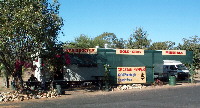 We visited the gold fossicking store at the caravan park, and were properly amazed at the detecting gadgets that abounded. Luckily we have no room for the many fascinating trinkets they had for sale. The proprietor (a middle-aged woman) told us she had only taken over the store six weeks earlier, but was transforming it from being oriented almost entirely to male interests, to one that catered equally for women, who she assured us were just as interested in fossicking, gemstones, and the like as the men were. Several strongly feminist paragraphs later, she had definitely endeared herself to us.
We visited the gold fossicking store at the caravan park, and were properly amazed at the detecting gadgets that abounded. Luckily we have no room for the many fascinating trinkets they had for sale. The proprietor (a middle-aged woman) told us she had only taken over the store six weeks earlier, but was transforming it from being oriented almost entirely to male interests, to one that catered equally for women, who she assured us were just as interested in fossicking, gemstones, and the like as the men were. Several strongly feminist paragraphs later, she had definitely endeared herself to us.
Our original plan was for a leisurely trip to Emerald, so we stopped in Capella, about halfway there from Clermont. The small town is named after a star, the eighth brightest, I believe. We met the friendly owner, John Hallan, of the Bottlebrush Motel store.
The rest area in the middle of town had toilets and showers, good news for long distance travellers. There was the historical pioneer village tourist attraction, a brand new and large Cultural Centre and an Aquatic Centre. Another plus: both of our mobile (cellular) phones (CDMA and GSM) worked.
Continuing on our way, we noted several large fields of stubble, with flocks of emus seeking food amongst the short stalks. Fluffy white stuff along the road verges proved to be cotton, not surprising given that cotton is a major crop in the area, so we concluded that the stubble was from cotton plants.
On into Emerald, where our mobile phones were still working. Emerald is much larger than other towns in the area, with about 12,000 people. Fairbairn Bakery sold us some wonderful meat pies for lunch and salad rolls for later. We noticed a park across the way, which was remarkable for the largest easel and painting we’ve ever seen, towering over most buildings.
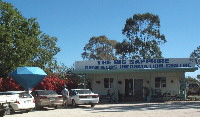 The park also had a tourist information center, toilets, and a dump point for black water (toilet waste) from caravans and motorhomes. Emerald made a point of allowing free overnight parking at the edge of the park area, a policy sure to encourage repeat visits. Again this year we didn’t stay to see the sights, as it’s a town that’s easy to get to by car and is on the way to several other places we’re likely to visit over the next few years.
The park also had a tourist information center, toilets, and a dump point for black water (toilet waste) from caravans and motorhomes. Emerald made a point of allowing free overnight parking at the edge of the park area, a policy sure to encourage repeat visits. Again this year we didn’t stay to see the sights, as it’s a town that’s easy to get to by car and is on the way to several other places we’re likely to visit over the next few years.
 We didn’t divert to Rubyvale or any of the other gem towns, either. Our next stop was Anakie, where we stopped briefly at the Big Sapphire gem shop, which sported a wonderful range of gems and fossicking gear. Later we stopped at the Drummond Range lookout, which had a great view of the valley we’d just come through.
We didn’t divert to Rubyvale or any of the other gem towns, either. Our next stop was Anakie, where we stopped briefly at the Big Sapphire gem shop, which sported a wonderful range of gems and fossicking gear. Later we stopped at the Drummond Range lookout, which had a great view of the valley we’d just come through.
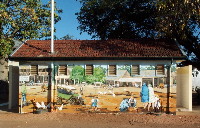 We finally reached Alpha around 4 pm, and decided continuing to Barcaldine that day wasn’t a good move. Once again, we failed to locate all the numerous murals in the town, although we did find several we hadn’t seen before. One pub didn’t have food on Sunday, and the other seemed noisy, so we went to the only cafe in town, which stayed open past 8 PM, where we had milkshakes and shared a salad sandwich, both large and tasty.
We finally reached Alpha around 4 pm, and decided continuing to Barcaldine that day wasn’t a good move. Once again, we failed to locate all the numerous murals in the town, although we did find several we hadn’t seen before. One pub didn’t have food on Sunday, and the other seemed noisy, so we went to the only cafe in town, which stayed open past 8 PM, where we had milkshakes and shared a salad sandwich, both large and tasty.
Alpha to Barcaldine
Monday 16 July 2001.
We drove from Alpha across the Great Dividing Range. At the top, an altitude of a mere 444 metres, we came upon a sign: “You are now entering the Lake Eyre Basin, Cooper’s Creek Catchment”. We didn’t expect to reach Lake Eyre for another two weeks at least, which shows the size of the drainage area involved. Also, considering that the last two years are the first time in decades that Lake Eyre has had water in it, it also shows how dry this continent is. Our skin is already cracking at the heels and elsewhere from the dryness, and a bath towel, put out on a rail, can be dry in as little as 30 minutes.

 We stopped in Jericho to view the Crystal Trumpeters sculpture. This depicts the destruction of the biblical Jericho and was created by the townsfolk. As in Alpha, numerous murals decorate the town. Next to the town hall in the main street is a small drive-in cinema with a small open-air grandstand holding the projectors and a number of canvas two seater chairs facing the screen. We’ve never seen one precisely like that before. Unfortunately, it appears to be no longer in use, a victim of videotape, presumably.
We stopped in Jericho to view the Crystal Trumpeters sculpture. This depicts the destruction of the biblical Jericho and was created by the townsfolk. As in Alpha, numerous murals decorate the town. Next to the town hall in the main street is a small drive-in cinema with a small open-air grandstand holding the projectors and a number of canvas two seater chairs facing the screen. We’ve never seen one precisely like that before. Unfortunately, it appears to be no longer in use, a victim of videotape, presumably.
We continued on to Barcaldine and checked in at the Homestead Caravan Park fairly early, a good move because it filled up early in the afternoon. Although my GSM phone did not work here, Jean’s CDMA did. This was the first mobile phone connection since Emerald. We wandered into Barcaldine, and had a steak sandwich with salad at the Artesian Hotel, in the main street opposite the railway station. Good food, and lots of it. The beers helped too.
We managed to find an Internet connection in the Open Learning Centre at the local Court House. Only $3 an hour (not prorated; you pay for an hour even if you use only a few minutes), and a reasonable connection.
That evening we attended the billy tea and damper session provided at the caravan park, and listened to Tom Lockie tell his stories of the history of the area. We took one of his tours last year and really enjoyed it.
Tuesday 17 July 2001.
We stayed at Barcaldine all day, doing very little. Around midday we went into town to get the newspaper and some lunch. This time we had the fish and chips at the Artesian Hotel, and were so full we could barely move when we had eaten the giant salad that came with it.
The local showground includes a Council caravan park, considerably cheaper than the Homestead, at $13 with the second night free. The showground had several toilets and hot showers, artesian tap water, and lots of electricity points around the perimeter, with plenty of space to spread out and get away from the crowd if you wanted to.
Blackall to Augathella
Wednesday 18 July 2001.
We were somewhat late leaving Barcaldine, as we refueled (189 litres of diesel, after only 780 km) and went into town to buy books at the information centre. I bought Heartbreak Corner, by Fleur Lehane, about the Tully and Durack and other pioneer families of South-West Queensland, and In the Tracks of Old Bluey, by Bobbie Buchanan, a biography of Nat Buchanan by his grand-daughter.
 Five kilometres south of Barcaldine along the road to Blackall, we turned right for the weir (dam), which was another 9 km along a single lane bitumen road that changed to dirt when it turned off a half kilometre from the weir. A number of caravans were camped by the weir, some of them having been there for a month, escaping the cold weather in the south. The facilities were limited, but did include a rainwater tank for drinking water, an artesian bore tap for washing, BBQ pits and tables, and two composting toilets.
Five kilometres south of Barcaldine along the road to Blackall, we turned right for the weir (dam), which was another 9 km along a single lane bitumen road that changed to dirt when it turned off a half kilometre from the weir. A number of caravans were camped by the weir, some of them having been there for a month, escaping the cold weather in the south. The facilities were limited, but did include a rainwater tank for drinking water, an artesian bore tap for washing, BBQ pits and tables, and two composting toilets.
We continued the 100 km to Blackall, encountering nothing else except another free camping area a few km before Blackall. We pulled into the Blackall Caravan Park around 1 pm, again good timing since the place filled up soon after we arrived. There was also a heavy vehicle camping area a few blocks over from the town centre, with lots of rooms for buses. The town centre included showers and toilets for this area. The camping fee is $5 per night, somewhat cheaper than the caravan park. Our guidebook suggested that staying there on the nights before stock sales was not recommended, presumably because one would be parked among road trains full of noisy, smelly cattle.
We wandered into town, and finally found a place for a light late snack of chicken, sun dried tomato and avocado sandwich. They sure don’t make outback food the way they used to (and a darn good thing, too). We didn’t want anything heavy as we had signed up for the caravan park’s $10 dinner of soup, lamb roast, vegetables, billy tea and damper at the caravan park that evening.
We then collected towels and swimming costumes and headed for the Aquatic Centre. A mere $1.50 each got us use of a 50 metre Olympic size pool, where the main problem was staying cool. As with most of the towns we had passed through, the local water supply is artesian, and you usually need to cool it before use. The pool temperature was 32 C, while the spa pool was 36 C, and the inlet water too hot to handle.
Thursday 19 July. After breakfast we visited the Black Stump, behind the State School, a tree used for surveying purposes in the 1880s. Allegedly the country west of Blackall was considered at the time to be “beyond the black stump”. (The Black Stump in Blackall is only one of several Black Stumps, all declared authentic, in various towns. Collect the entire set.)
After breakfast we visited the Black Stump, behind the State School, a tree used for surveying purposes in the 1880s. Allegedly the country west of Blackall was considered at the time to be “beyond the black stump”. (The Black Stump in Blackall is only one of several Black Stumps, all declared authentic, in various towns. Collect the entire set.)
Blackall is also known for the legendary shearer Jack Howe, who lived and died there (in 1992 he shore a record of 321 sheep in 7 hours 40 minutes) and for being the location of the first meeting of the first shearers’ union in December 1886. The group moved its headquarters to Barcaldine, and later became the Australian Labor Party.

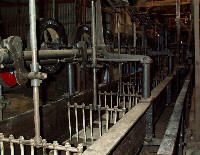 Next we drove 4 km out of town to the historic woolscour, where the 58 degree artesian water makes a good resource for cleaning greasy wool. We took the tour, which was very interesting. In addition to a 20-stand shearing shed, the complex includes a full steam-powered wool washing plant full of old belt-driven open machinery, powered by a gigantic steam engine. They had many engines, in various states of disassembly and repair. After the scour was abandoned around 1978, the machinery was neither vandalised nor removed, so essentially everything is complete. The tour guide told us that many of the pieces started working once they had been oiled and greased again over a period of weeks. They also obviously have a lot of mechanically minded helpers doing repairs and making replacement parts for the brass and bronze fittings.
Next we drove 4 km out of town to the historic woolscour, where the 58 degree artesian water makes a good resource for cleaning greasy wool. We took the tour, which was very interesting. In addition to a 20-stand shearing shed, the complex includes a full steam-powered wool washing plant full of old belt-driven open machinery, powered by a gigantic steam engine. They had many engines, in various states of disassembly and repair. After the scour was abandoned around 1978, the machinery was neither vandalised nor removed, so essentially everything is complete. The tour guide told us that many of the pieces started working once they had been oiled and greased again over a period of weeks. They also obviously have a lot of mechanically minded helpers doing repairs and making replacement parts for the brass and bronze fittings.
We left the Blackall area around 10 am. Jean was still getting CDMA phone reception at times until we were 50 or so km from town. We pulled into a truck rest stop about 25 km short of Tambo, and were surprised to see it had a couple of shelter sheds, a BBQ area, rubbish bins, an artesian water tap, and toilets.
We reached Tambo at midday and did part of the historic walk listed by the information centre. Alas, most old buildings were incorporated into newer ones, and without signs, we really couldn’t tell which ones had even contained older parts. They did have a fine old post office and courthouse, both being restored. We visited the Tambo Teddies shop and saw wonderful teddy bears made of sheepskin and stuffed with wool – so cuddly.
We had lunch at a service station near the Post Office, where the salad rolls were again so large that we could easily have shared one. We also checked the parking area near the lake at the southern end of town. It looked like a very pleasant place, with toilets and shelter sheds. Fuel in the nearby service station was pretty reasonably priced (for country Australia) so we topped up again.

 We reached Augathella just after 3 pm. The town was a bit of a walk away and didn’t contain much of interest except some wire sculptures outside the local pub. One sculpture was a giant mosquito; the other was two men sitting at a table and drinking beer. These were really nice, with fascinating detail (including antennas on the men; don’t ask us why), although our photos don’t do them justice.
We reached Augathella just after 3 pm. The town was a bit of a walk away and didn’t contain much of interest except some wire sculptures outside the local pub. One sculpture was a giant mosquito; the other was two men sitting at a table and drinking beer. These were really nice, with fascinating detail (including antennas on the men; don’t ask us why), although our photos don’t do them justice.
The pub included the TAB and betting facilities, with several televisions, and the noise from that made us unwilling to stay. We went back to the highway, and had dinner at the roadhouse. Four lamb chops and vegetables, with the lamb a bit on the tough and overcooked side – the first meal we’ve had that was less than great.
The Murweh Shire, which contains Augathella, Charleville, Morven (and Cooladdi, population 6) covers 43,905 sq km and has 5400 residents.
Charleville and bilbies
Friday 20 July 2001.
The drive to Charleville from Augathella was short, so we were soon parked at the Bailey Bar Top Tourist caravan park. Owner Rick was exceedingly efficient at getting us into a spot. We went for a long dusty walk past the National Parks and Wildlife place and (despite an inaccurate tourist map) out to the Information Centre, situated near a pleasant park at bit out of town. The Aboriginal arts and crafts place across the street wasn’t open, so we walked back into town.
We found the local library had an internet connection, at fairly high prices, so Jean arranged a booking for Saturday. A bakery in town also had one Internet machine at a dollar less an hour. We lunched at the Charleville pub on their $5 special (crumbed chicken and vegetables). This meal proved so large we knew we wouldn’t need more than a snack for dinner.
The caravan park had a 4 pm singalong with bush poets. The amplified music always sets our teeth on edge, so we didn’t attend. In the evening we walked back to the National Parks and Wildlife place for a talk about bilbies, an endangered species. This cute furry animal (sometimes called the rabbit eared bandicoot or walpatjirri) eats almost anything, doesn’t need to drink water (and thus can survive even in waterless deserts), and breeds like rabbits, yet it is almost extinct. (Feral cats are now the main predator.) If we can’t figure out how to save that one, we probably can’t save any small native animal in Australia. The NPWS has a breeding program and one of their employees, Frank Manthey, on his own time, organised a public campaign to raise A$300,000 to build a predator-proof fence to enclose a 5 km x 5 km bilby sanctuary in a nearby national park. He was introduced to the nocturnal bilbies years ago by zoologist Peter McRae. Great stuff.
After the talk we got to see some of the bilbies, which are really cute little critters about the size of a small cat. We’d seen videos but never the real live animals, which are totally nocturnal as well as rare.
For more about bilbies, see the Bilby Appreciation Society and other links from our page, https://avalook.com.au/newsletr/oznews11.htm#bilby.
Saturday 21 July 2001.
Today was a rest day, so we did laundry early in the morning. There was a mournful howl in the predawn light, an anguished cry. Was it a hunting cry, the Hound of the Baskervilles? More a whimper, the Hound of the Charlevilles. We later met Barney, the hound. The amenities blocks here, as at many caravan parks, are designed for hot weather. Walls tend to start high and end low, leaving an airspace for cooling breezes. Unfortunately, in winter a bitter cold takes the place of the pleasant breezes of summer, so showering is more of an adventure than we’d prefer.
We were at the library around 9 am for Jean’s internet session. While waiting for her, I read about the flood of 1990, which extended from Alpha and Longreach down into NSW as far as Nyngan, where 1130 homes out of 1160 were flooded, with flood heights of 5 to 11 metres above the normally dry creek beds.
We ate lunch at the same pub as yesterday. Cajun red emperor and stir fry vegetables was the special this time – delicious.
For more information about places mentioned
Two good sites for more information about the places mentioned in this newsletter are Travelmate and Walkabout.
